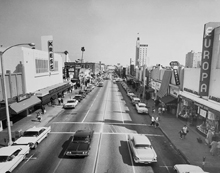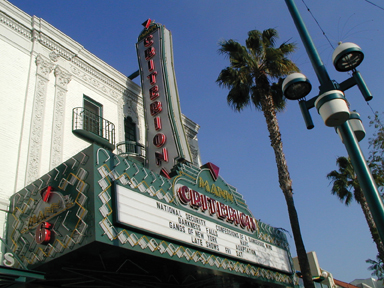By Jorge Casuso
In the 1980s, City officials and business leaders had agreed to make over the dying Santa Monica Mall along Third Street. But what would they put there to draw all the shoppers that were being siphoned by the new indoor mall at the end of the strip? The answer would serve as a model for outdoor malls across America, and even abroad.
Second of two parts
September 21, 2009 -- If City officials were looking for some radical ideas, that wasn’t what they got when the board members took their seats during a meeting of the recently-formed Third Street Development Corporation. Zane recalls that the consultants pinned up a map with a land use plan, and the board was asked to comment.
“Every board member said, ‘No problem. Looks okay. Looks fine,’” Zane says.
But Zane found it boring. “There’s no there there, no destination, no strategy, no central vision,” he recalls telling the board. “It’s just a land use map. Why would anyone come here?”
But when asked for his idea, the council liaison had no answer. No one else did either. The item was tabled for two weeks.
Though they hadn’t hit on an answer, Zane, whose wife was from Quebec, a city that closed part of the main street in summer for outdoor dining, and Kaplan, who’d visited Rome and Czechoslovakia and loved the street life there, sensed the answer was outside of America.
 |
| Like other Los Angeles area streets, 3rd Street sidewalks were too narrow for outdoor dining. |
|
“I’m saying to myself, ‘Why don’t we have outdoor dining anywhere in Los Angeles?’ The sidewalks are too narrow,” Zane recalls. “The answer was an outdoor dining district. People love to see people, have a good time, and while they’re here spend money.” |
“We needed the magnets,” Kaplan says. “What would bring people here? We started to free flow. We needed a place where you could sit and eat and watch the world go by.”
The other board members liked the idea, but no one knew how to pull it off. Soon, the key players were on a plane to Boulder, Colorado, where local restaurateur Michael McCarty showed them his restaurant with outdoor dining. By the end of dinner, Zane says, the group was sold on the idea.
“Everybody was enthusiastic,” Zane says. “Outdoor cafes had been in the plan, but as an afterthought. Thereafter, they became a driving theme.”
It was now time to come up with a name, and once again, the group drew a blank. Kaplan recalls the board members dropped their suggestions into a hat, then voted on the names.
Zane proposed “La Plaza del Corazon de Santa Monica.” No one cared for the suggestion. “He gets too romantic,” Kaplan says. Someone else suggested the Santa Monica Town Center. That was too boring.
No one seems to agree on who came up with the name, but everyone agrees it was the right choice. From now on, the old Santa Monica Mall would be called the “Third Street Promenade.”
The idea of bringing outdoor dining and calling the street the Promenade had been the result of brainstorming sessions in the boardroom. But one of the other key ingredients came as if by chance.
The board had envisioned movie theaters as a component of the mix, but no one thought there was any realistic chance of luring them to the strip. After all, why would major movie chains want to open new venues that would compete with their existing movie houses in nearby Westwood and Marina del Rey?
Then, in 1987, the City suddenly received a proposal to develop a movie theater at the site of the bowling alley near 2nd Street and Pico Boulevard. Two other proposals would soon follow.
 |
Three theaters followed the Criterion to the Promenade. |
“Suddenly (the proposals) were all there. In a month. Out of the blue. Near residences,” Zane says. “How do you make the bad idea a good idea. How do you avoid having a neighborhood uprising?”
The answer was to craft an ordinance, approved in October 1987, that would only allow new theaters on the Third Street Promenade and restrict the total number of seats to 1,700. “We didn’t want to become overwhelmed with theaters like Westwood,” Zane says.
The City Council grand-fathered in the 1,000 seats at the Criterion Theater on Third Street, the theater owners bought into the plan and the Promenade had three new movie theaters all lined up.
IT WAS TIME TO START the $13.3 million construction project. The new strip – which required much-needed public improvements – would be largely bankrolled with the assessments paid by property owners and some money from the City.
The street would belong to the people, and it was the people themselves who would help to design it. The Third Street Redevelopment Corporation lit up empty storefronts and held community workshops where the public was asked to tackle different aspects of the design.
“People got on their hands and knees and crawled on the paper and drew lines and placed little trees and fountains and benches and little figurines like you have in electric train sets,” Kaplan recalls.
Roma Design, a San Francisco-based firm, was hired to design the new strip based on the public input – the landscaping, the street furniture, the lighting, in effect, the general look. The new street would have pavilions and feature vending carts, like those found in European cities.
The design would break up the uninterrupted surface that stretched across the street from façade to façade. Instead, the new Promenade would be divided into a series of “zones” – a dining zone next to the facades on either side of the street, flanked by a walking zone, with the street running down the middle.
“We wanted to divide the space, design it and organize it in a different way,” Curran says. “We wanted to retain the option of having limited traffic come through.”
Boris Dramov, a principal of Roma Design, came up with a simple, but elegant solution – put retractable bollards at both ends of the street. If the experiment didn’t work, they could always be removed.
Construction was moving along when artist Bruria Finkel, a vocal champion of public art, asked a simple question: “What’s the art component?” The art, she was told, would come after construction was completed.
“No,no,no,no,no,” Finkel recalls having said. "You must design the art program to be integrated into the construction. Otherwise, it will be plopped art. You must stop construction now.”
“She convinced us that she was right,” Zane says. “That something important would be lost.”
Construction was halted for three months while the City held an international arts competition. The community and, ultimately, the City Council would weigh in on the winning public artwork. Images of the proposals were displayed in storefront windows, and the public was asked to vote.
In the end, all the parties agreed – the topiary dinosaur fountains won hands down. Initially, the dinosaurs on either side of Arizona Avenue spewed fire from their mouths at night, a feature that was short-lived after the City’s risk management stepped in.
“Everyone relates to a dinosaur,” Kaplan says. “Who didn’t grow up with dinosaurs? We didn’t make these decisions in a vacuum. It was a very democratic process.”
ON SEPTEMBER 16, 1989, a clear Southern California Day, city officials cut the ribbon on the Promenade. The citizens who gathered then strolled down the newly constructed street. They would come back again and again.
The street quickly took off. In the early 1990s, nearby Westwood Village suddenly collapsed after a rash of gang violence emptied its streets, and the Promenade soon became one of the Los Angeles area’s biggest attractions. In fact, it became so successful, the City Council would spend the next two decades trying to manage its success as rental prices skyrocketed and retail chains moved in.
Street performers also began to flock to the Promenade, drawn by the large crowds and the promise of being discovered. There was an animal trainer and a midget Elvis and two tap dancing brothers and at least one legendary bluesman.
“People have come from all over the world to this place,” says Ned Landin, a street performer and activist. “Clubs have closed down. There are fewer open mics. This allows (live performances) to happen. It attracts quality acts from all over the world.”
The unprecedented success of the Promenade has made it a model for the future of outdoor malls — a cross between an old-fashioned central plaza and a commercial strip. And the wary officials who instinctively laid the groundwork a quarter century ago now lecture on its success to audiences around the world.
“We had the belief. It wasn’t a surprise,” says Jeff Mathieu, the City’s former resource manager who was the City official in charge of the new strip. “This looked like a natural.
“There is no other environment like it.”
“I thought it could be successful, but I never envisioned it would be the success it became,” Kaplan says. “It’s a model. People come from around the world from governments to study it.
“We dreamed, and the dream is out there to see.”
It is a perfect summer’s day as Zane strolls the Promenade. Music is playing, the outdoor cafes are full.
“This is the sweetest place in the world on a sunny afternoon,” he says.